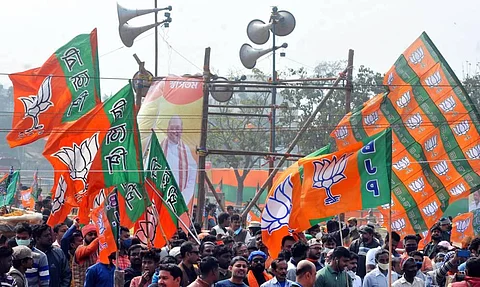

“Bengal is different as here people take time to change the incumbent. But when desired, they make up their mind beforehand and choose to remain silent until the day of voting. This happened in 1977 and 2011. This will happen in 2021 again,” opined an elderly OBC person at Lalgarh in the Jhargram assembly constituency.
The statement was not in isolation but it signified an articulated summing up of the dominant mood for change that is prevalent on the ground, a fact that resonated in my field study in all the 294 assembly constituencies of West Bengal.
At present, barring the Muslim respondents, the mood for change could be positively tested on the ground if one could go for a random but demographically representative response from the voters across the state, from Dalits like Rajbanshis, Namoshudras and Chain Mandals, tribes like tea-tribes and a section of Gorkhas, general Hindu Bengalis and Hindi speakers in North-Bengal, a sub-region lying between Bihar and Jharkhand on the western side and Nepal, Bhutan, Assam and Bangladesh on the northern and eastern sides respectively.

The contradiction between NRC and CAA is immaterial to them as both are meant to stop the illegal infiltration of Muslims from Bangladesh, opined a Rajbanshi Dalit in Toofangunj constituency.
Where would the Hindus from Bangladesh go if not to India, he countered upon being pointed out that the majority of illegal immigrants happen to be Hindus, particularly the Namoshudra Dalits?
This sentiment is shared further on the western side of the state sharing the borders of Jharkhand and Odisha, the sub-regions referred to as Paschimanchal and Junglemahal respectively, from Birbhum to Paschim-Bardhman and Purulia, Bankura, Jhargram to West Medinipur, inhabited primarily by Bauri and Bagdi Dalit castes, Santhal and Munda tribes, OBCs like Kurmi-Mahatos, besides the general Hindu castes like Brahmins, Kayasthas and peasant castes like Mahishyas and Aguris. The sentiment for change is prevalent.
Similarly, the pro-change sentiment is also shared both in degree and kind in central Bengal, composed of districts like Purba Bardhman, Nadia and Hooghly wherein we found the same demography, albeit with fewer STs and more concentration of Bagdi Dalits and castes like Aguris, Mahishyas, Gwala Ghosh, Brahmins and Kayasthas.
Lastly in southern Bengal, we found dense pockets of Namoshudra Dalits in North-24 Parganas, Poundra-Kshatriya Dalits in South-24 Parganas, Bagdi Dalits in Howrah and East-Medinipur besides Mahishyas and Gwala Ghosh communities along with the presence of migrant communities and general castes with the core of Bhadraloks residing in and around Kolkata.
Here, barring a minuscule section of Bhadraloks, that too mainly in South-Kolkata, one finds the votaries of pro-change superseding the status quoits. But, this seamless demographic flow is interspersed with Muslim minorities who are veering towards the Trinamool Congress in a big way.
Nevertheless, their impact gets limited in the face of a thick consolidation of Hindu votes in favour of the BJP.
Hence, contrary to the common-sensical assumption that the TMC may be weakened and the saffron wave is strengthening on account of the defection of strong leaders like Suvendu Adhikari and others to the BJP, it is the prevalent pro-change sentiment on the ground which is encouraging these leaders to defect with the intention to ride on the strong tailwind of pro-change sentiment.
Attributing an expected BJP victory in Bengal to individual leaders would be a classic case of analytical fallacy wherein effect is confused as the cause.
Naturally, there are strong sceptics, including seasoned analysts. But, in the age of social media and with the rise of a new wave of politics, their scepticism is based more on the old set of assumptions wherein they are strong on logics but thin on empirics.
Firstly, the oft-referred cliché of assembly election being different from the Lok Sabha election doesn’t hold ground in Bengal as the electoral determinants of a strong anti-incumbency against the Trinamool on account of rampant corruption and political violence, which prevailed in 2019, is still the prime factor on the ground.
In fact, people have got further emboldened in the face of the organizational chaos gripping the Trinamool. Secondly, while it is rightly pointed out that in West Bengal the BJP is organizationally weak and lacks local faces on the ground in addition to not having a state leader of Mamata Banerjee’s stature, it would be wrong to infer that these weaknesses would prevent the BJP from capturing power in the ensuing election.
People are not casting a positive vote for the BJP, rather they will vote to defeat the Trinamool wherein the BJP is the preferred option, mainly on account of it being in power at the Centre and having leaders like Prime Minister Narendra Modi and Amit Shah, who are perceived to be serious about their intent to win Bengal by all means.
This faith in the capability and intent of the BJP leaders rather than the party’s organizational strength was visible when a majority of pro-change respondents said they would vote for the party rather than the candidate. This leader centric approach was further revealed when in October a significant section of pro-change respondents stated that in Bengal, the BJP needs Shah more than party president J P Nadda.
Till then Shah, after skipping the Bihar election completely, had not started his Bengal visits, leading to doubts about his presence in the state. Now, with prevailing ground sentiment and BJP sending the right signals, thereby striking a chord with a majority of the electorates, the momentum for change is too strong to be dipped. Winds of change are blowing in Bengal.
Sajjan Kumar Political analyst associated with People's Pulse